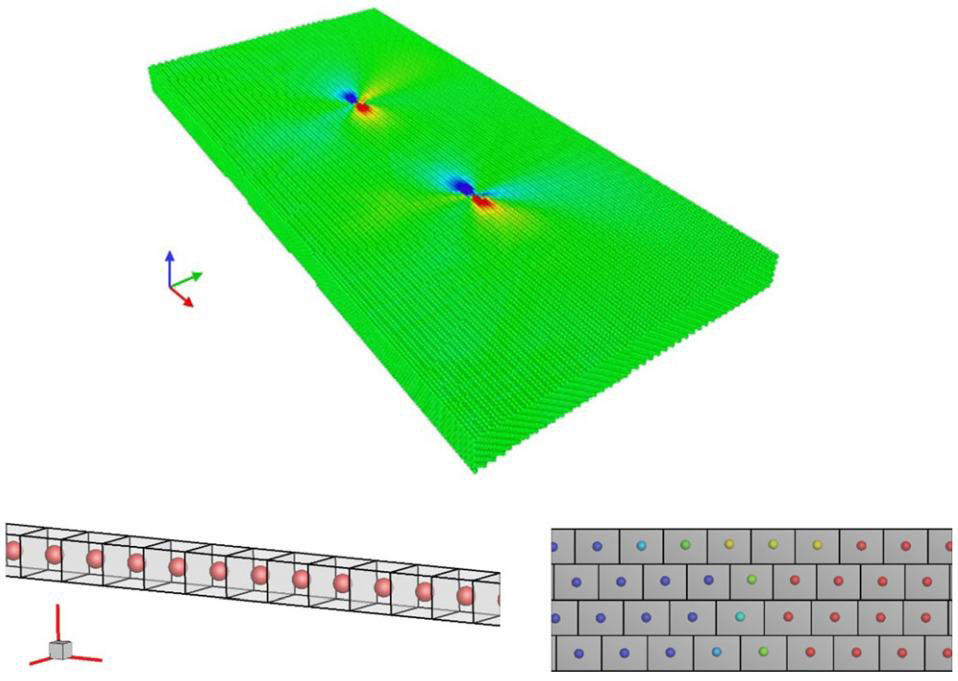

 Skip to navigation
Skip to navigation
Site Primary Navigation:
- About SDSC
- Services
- Support
- Research & Development
- Education & Training
- News & Events
Search The Site:

Published December 4, 2018

Supercomputer simulations show that at the atomic level, material stress doesn't behave symmetrically. Molecular model of a crystal containing a dissociated dislocation, atoms are encoded with the atomic shear strain. Below, snapshots of simulation results showing the relative positions of atoms in the rectangular prism elements; each element has dimensions 2.556 Å by 2.087 Å by 2.213 Å and has one atom at the center. Credit: Liming Xiong
Written by Jorge Salazar
Scientists can take a lot for granted when they study stress, the force per unit area on an object. They handle stress mathematically by assuming it to have symmetry. That means the components of stress are identical if one transforms the stressed object with something such as a turn or a flip.
Now, supercomputer simulations show that at the atomic level, material stress doesn't behave symmetrically. The findings, published in September 2018 in the Proceedings of the Royal Society A, could help scientists design new materials such as glass or metal that doesn't ice up.
“The commonly accepted symmetric property of a stress tensor in classical continuum mechanics is based on certain assumptions, and they will not be valid when a material is resolved at an atomistic resolution,” said study co-author Liming Xiong, an assistant professor in the Department of Aerospace Engineering at Iowa State University. “The widely used atomic Virial stress or Hardy stress formulae significantly underestimate the stress near a stress concentrator such as a dislocation core, a crack tip, or an interface, in a material under deformation.”
Xiong and his colleagues treated stress in a different way than classical continuum mechanics, which assumes that a material is infinitely divisible such that the moment of momentum vanishes for the material point as its volume approaches zero. Instead, they used the definition by mathematician A.L. Cauchy of stress as the force per unit area acting on three rectangular planes. With that, they conducted molecular dynamics simulations to measure the atomic-scale stress tensor of materials with inhomogeneities caused by dislocations, phase boundaries, and holes.
The computational challenges, said Xiong, swell up to the limits of what's currently computable when one deals with atomic forces interacting inside a tiny fraction of the space of a raindrop. “The degree of freedom that needs to be calculated will be huge, because even a micron-sized sample will contain billions of atoms. Billions of atomic pairs will require a huge amount of computation resource.”
What's more, added Xiong, is the lack of a well-established computer code that can be used for the local stress calculation at the atomic scale. His team used the open-source LAMMPS Molecular Dynamics Simulator, incorporating the Lennard–Jones interatomic potential and modified through the parameters they worked out in the paper.
“Basically, we're trying to meet two challenges,” said Xiong. “One is to redefine stress at an atomic level. The other one is, if we have a well-defined stress quantity, can we use supercomputer resources to calculate it?”
Enter Comet and Jetstream
Xiong was awarded supercomputer allocations via the National Science Foundation-funded eXtreme Science and Engineering Discovery Environment (XSEDE), on the Comet supercomputer system at the San Diego Supercomputer Center at UC San Diego; and Jetstream, a cloud environment supported by Indiana University, the University of Arizona, and the Texas Advanced Computing Center.
“Jetstream is a very suitable platform to develop a computer code, debug it, and test it,” said Xiong. “Jetstream is designed for small-scale calculations, not for large-scale ones. Once the code was developed and benchmarked, we ported it to the petascale Comet system to perform large-scale simulations using hundreds to thousands of processors.”
What impressed the research group most about Jetstream was the cloud monitoring. “During the debugging stage of the code, we really needed to monitor how the code is performing during the calculation. If the code is not fully developed, if it's not benchmarked yet, we don't know which part is having a problem. The cloud monitoring can tell us how the code is performing while it runs. This is very unique,” said Xiong.
Xiong and his research group are working on several projects to apply their understanding of stress to design new materials with novel properties. “One of them is de-icing from the surfaces of materials,” Xiong explained. "A common phenomenon you can observe is ice that forms on a car window in cold weather. If you want to remove it, you need to apply a force on the ice. The force and energy required to remove that ice is related to the stress tensor definition and the interfaces between ice and the car window. Basically, the stress definition, if it's clear at a local scale, it will provide the main guidance to use in our daily life.”
Xiong sees great value in the computational side of science. “Nowadays, people want to speed up the development of new materials. We want to fabricate and understand the material behavior before putting it into mass production. That requires a predictive simulation tool… which really considers materials as a collection of atoms. The degree of freedom associated with atoms will be huge. Even a micron-sized sample will contain billions of atoms. Only a supercomputer can help.”
About SDSC
As an Organized Research Unit of UC San Diego, SDSC is considered a leader in data-intensive computing and cyberinfrastructure, providing resources, services, and expertise to the national research community, including industry and academia. Cyberinfrastructure refers to an accessible, integrated network of computer-based resources and expertise, focused on accelerating scientific inquiry and discovery. SDSC supports hundreds of multidisciplinary programs spanning a wide variety of domains, from earth sciences and biology to astrophysics, bioinformatics, and health IT. SDSC’s petascale Comet supercomputer is a key resource within the National Science Foundation’s XSEDE (eXtreme Science and Engineering Discovery Environment) program.
Share